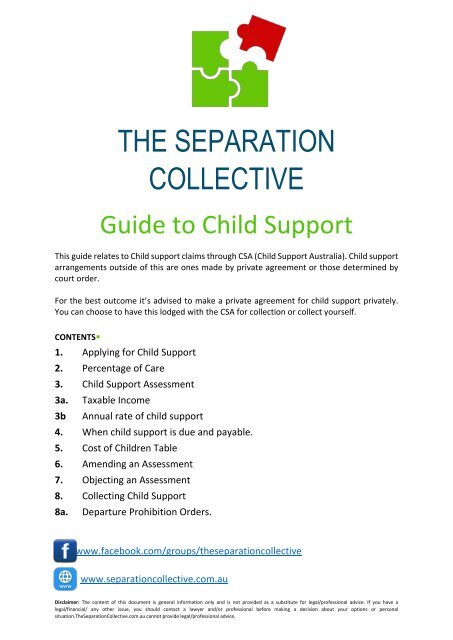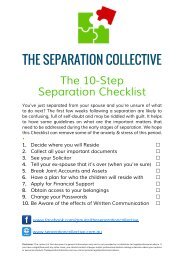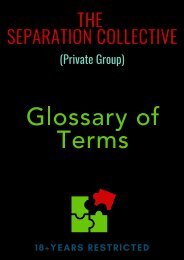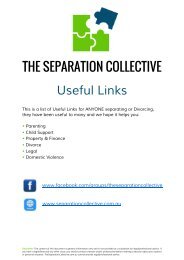A Guide to Child Support
This guide relates to Child support claims through CSA (Child Support Australia). Child support arrangements outside of this are ones made by private agreement or those determined by court order. For the best outcome it’s advised to make a private agreement for child support privately. You can choose to have this lodged with the CSA for collection or collect yourself.
This guide relates to Child support claims through CSA (Child Support Australia). Child support arrangements outside of this are ones made by private agreement or those determined by court order.
For the best outcome it’s advised to make a private agreement for child support privately. You can choose to have this lodged with the CSA for collection or collect yourself.
- TAGS
- child-support
You also want an ePaper? Increase the reach of your titles
YUMPU automatically turns print PDFs into web optimized ePapers that Google loves.
THE SEPARATION<br />
COLLECTIVE<br />
<strong>Guide</strong> <strong>to</strong> <strong>Child</strong> <strong>Support</strong><br />
This guide relates <strong>to</strong> <strong>Child</strong> support claims through CSA (<strong>Child</strong> <strong>Support</strong> Australia). <strong>Child</strong> support<br />
arrangements outside of this are ones made by private agreement or those determined by<br />
court order.<br />
For the best outcome it’s advised <strong>to</strong> make a private agreement for child support privately.<br />
You can choose <strong>to</strong> have this lodged with the CSA for collection or collect yourself.<br />
CONTENTS▪<br />
1. Applying for <strong>Child</strong> <strong>Support</strong><br />
2. Percentage of Care<br />
3. <strong>Child</strong> <strong>Support</strong> Assessment<br />
3a. Taxable Income<br />
3b Annual rate of child support<br />
4. When child support is due and payable.<br />
5. Cost of <strong>Child</strong>ren Table<br />
6. Amending an Assessment<br />
7. Objecting an Assessment<br />
8. Collecting <strong>Child</strong> <strong>Support</strong><br />
8a. Departure Prohibition Orders.<br />
www.facebook.com/groups/theseparationcollective<br />
www.separationcollective.com.au<br />
Disclaimer: The content of this document is general information only and is not provided as a substitute for legal/professional advice. If you have a<br />
legal/financial/ any other issue, you should contact a lawyer and/or professional before making a decision about your options or personal<br />
situation.TheSeparationCollective.com.au cannot provide legal/professional advice.
1. Applying for <strong>Child</strong> <strong>Support</strong><br />
A parent can apply for a child support assessment for a child if they are not living with<br />
the other parent of the child as their partner.<br />
Both parents are assessed in respect of the costs of the children, the roles of payer and<br />
payee and the amount of child support payable will depend on the incomes of both<br />
parents and the care they each provide for the children. If the income and/or care<br />
percentage changes, the roles may reverse, and the child support assessment will<br />
continue without the need for a new application for child support.<br />
2. Percentage of Care<br />
A parent or non-parent carer's percentage of care for a day in a child support period is the<br />
percentage of care that the person is likely <strong>to</strong> have of the child during the care period.<br />
Care will generally be worked out based on the number of nights that the child is likely <strong>to</strong><br />
be in the care of the person during the care period.<br />
Where parents are separated but living in the same house, the Registrar will determine<br />
each parent's percentage of care for a child based on the individual circumstances of the<br />
case and evidence available. Generally, where the parents contribute in a similar manner<br />
<strong>to</strong> the care of the child, they will be regarded as sharing equally in the care of the child. In<br />
this case, the Registrar will determine that each parent has a care percentage of 50%.<br />
Additionally, in limited circumstances, a person may have care of a child who is not living<br />
with them for a period of time. For example, a person can provide care for a child who is<br />
at boarding school, in hospital or in separate accommodation. However, a person who<br />
simply supervises the child (for example, a baby sitter, a child minder such as a<br />
grandparent or a schoolteacher) does not provide care.<br />
Consideration is given <strong>to</strong> who has responsibility for making arrangements for, and<br />
decisions about, the child's welfare, as well as who is meeting the child's costs, rather than<br />
just the accommodation arrangements themselves. The Registrar will give weight <strong>to</strong><br />
statements from both parents and any non-parent carers.<br />
A parent or non-parent carer's percentage of care for a child will be used <strong>to</strong> determine the<br />
parent's or non-parent carer's cost percentage for the child.<br />
Click here for the <strong>Child</strong> <strong>Support</strong> Care Estima<strong>to</strong>r<br />
Disclaimer: The content of this document is general information only and is not provided as a substitute for legal/professional advice. If you have a<br />
legal/financial/ any other issue, you should contact a lawyer and/or professional before making a decision about your options or personal<br />
situation.TheSeparationCollective.com.au cannot provide legal/professional advice.
3. <strong>Child</strong> <strong>Support</strong> Assessment<br />
The child support income of both parents is used <strong>to</strong> calculate their child support<br />
assessment.<br />
3a Taxable Income<br />
A parent's adjusted taxable income is the <strong>to</strong>tal of the following components:<br />
• taxable income for the last relevant year of income (including overseas<br />
income if the parent is a resident of a reciprocating jurisdiction)<br />
• reportable fringe benefits <strong>to</strong>tal for that year of income<br />
• target foreign income for that year of income<br />
• the parent's <strong>to</strong>tal net investment loss for that year of income<br />
• the <strong>to</strong>tal of the specified tax free pensions or benefits received in that year<br />
of income, and<br />
• the parent's reportable superannuation contributions.<br />
3b. Annual rate of child support<br />
If a parent has a positive child support percentage under step 6, the annual rate of child<br />
support payable by the parent for the child is worked out using the formula:<br />
<strong>Child</strong> support percentage × Costs of the child<br />
Click here for the <strong>Child</strong> <strong>Support</strong> Estima<strong>to</strong>r<br />
The minimum rate of child support payable per annum for 2021 is $446.<br />
4. When child support is due & payable<br />
A child support assessment creates a liability owed by a liable parent <strong>to</strong> a payee. The CSA<br />
Act sets out when a liability is due and payable<br />
<strong>Child</strong> support payable in relation <strong>to</strong> any day in a month becomes due and payable on:<br />
• the 7th day of the following month, or<br />
• the 30th day after the liable parent concerned was given a notice of<br />
assessment<br />
Disclaimer: The content of this document is general information only and is not provided as a substitute for legal/professional advice. If you have a<br />
legal/financial/ any other issue, you should contact a lawyer and/or professional before making a decision about your options or personal<br />
situation.TheSeparationCollective.com.au cannot provide legal/professional advice.
5. Cost of <strong>Child</strong>ren Table<br />
Fraction of<br />
MTAWE<br />
0.5 1 1.5 2 2.5 no increase<br />
above this cap<br />
No. of<br />
children<br />
$0 <strong>to</strong> $39,479 $39,480 <strong>to</strong><br />
$78,957<br />
$78,958 <strong>to</strong><br />
$118,436<br />
$118,437 <strong>to</strong><br />
$157,914<br />
$157,915 <strong>to</strong><br />
$197,393<br />
Income over<br />
$197,393<br />
<strong>Child</strong>ren aged 0-12 years<br />
1 child 17c for each $1 $6,711 plus 15c<br />
for each $1<br />
over $39,479<br />
$12,633 plus<br />
12c for each $1<br />
over $78,957<br />
$17,370 plus 10c<br />
for each $1 over<br />
$118,436<br />
$21,318 plus 7c for<br />
each $1 over<br />
$157,914<br />
$24,082<br />
2 children 24c for each $1 $9,475 plus 23c<br />
for each $1<br />
over $39,479<br />
$18,555 plus<br />
20c for each $1<br />
over $78,957<br />
$26,451 plus 18c<br />
for each $1 over<br />
$118,436<br />
$33,557 plus 10c<br />
for each $1 over<br />
$157,914<br />
$37,505<br />
3 + children 27c for each $1 $10,659 plus<br />
26c for each $1<br />
over $39,479<br />
$20,923 plus<br />
25c for each $1<br />
over $78,957<br />
$30,793 plus 24c<br />
for each $1 over<br />
$118,436<br />
$40,268 plus 18c<br />
for each $1 over<br />
$157,914<br />
$47,374<br />
<strong>Child</strong>ren aged 13 + years<br />
1 child 23c for each $1 $9,080 plus 22c<br />
for each $1<br />
over $39,479<br />
$17,765 plus<br />
12c for each $1<br />
over $78,957<br />
$22,502 plus 10c<br />
for each $1 over<br />
$118,436<br />
$26,450 plus 9c for<br />
each $1 over<br />
$157,914<br />
$30,003<br />
2 children 29c for each $1 $11,449 plus<br />
28c for each $1<br />
over $39,479<br />
$22,503 plus<br />
25c for each $1<br />
over $78,957<br />
$32,373 plus 20c<br />
for each $1 over<br />
$118,436<br />
$40,269 plus 13c<br />
for each $1 over<br />
$157,914<br />
$45,401<br />
3 + children 32c for each $1 $12,633 plus<br />
31c for each $1<br />
over $39,479<br />
$24,871 plus<br />
30c for each $1<br />
over $78,957<br />
$36,715 plus 29c<br />
for each $1 over<br />
$118,436<br />
$48,164 plus 20c<br />
for each $1 over<br />
$157,914<br />
$56,060<br />
<strong>Child</strong>ren of mixed age<br />
2 children 26.5c for each<br />
$1<br />
$10,462 plus<br />
25.5c for each<br />
$1 over $39,479<br />
$20,529 plus<br />
22.5c for each<br />
$1 over $78,957<br />
$29,412 plus 19c<br />
for each $1 over<br />
$118,436<br />
$36,913 plus 11.5c<br />
for each $1 over<br />
$157,914<br />
$41,453<br />
3 + children 29.5c for each<br />
$1<br />
$11,646 plus<br />
28.5c for each<br />
$1 over $39,479<br />
$22,897 plus<br />
27.5c for each<br />
$1 over $78,957<br />
$33,754 plus 26.5c<br />
for each $1 over<br />
$118,436<br />
$44,216 plus 19c<br />
for each $1 over<br />
$157,914<br />
$51,717<br />
Disclaimer: The content of this document is general information only and is not provided as a substitute for legal/professional advice. If you have a<br />
legal/financial/ any other issue, you should contact a lawyer and/or professional before making a decision about your options or personal<br />
situation.TheSeparationCollective.com.au cannot provide legal/professional advice.
6. Amending an Assessment<br />
The CSA can amend an assessment <strong>to</strong> take in<strong>to</strong> account changed circumstances.<br />
The reasons why an assessment may be amended include (but are not limited <strong>to</strong>):<br />
• correcting any error or mistake (whether or not made by the CSA)<br />
• correcting the effect of any false or misleading statement made <strong>to</strong> the Registrar<br />
• giving effect <strong>to</strong> a terminating event<br />
• giving effect <strong>to</strong> a care determination or interim care determination<br />
• giving effect <strong>to</strong> a change in a parent's or non-parent carer's percentage of care<br />
• giving effect <strong>to</strong> an event or change of circumstances that affects the annual rate of<br />
child support<br />
• giving effect <strong>to</strong> the Registrar's acceptance of a child support agreement<br />
• giving effect <strong>to</strong> a decision of the AAT, or<br />
• giving effect <strong>to</strong> a decision or order of a court which has jurisdiction under either the<br />
CSA Act, CSRC Act or AAT Act.<br />
7. Objecting an Assessment<br />
Unless it is <strong>to</strong> correct an error or mistake, generally, the CSA will not change a decision<br />
once it has been made.<br />
A parent may lodge an objection if they want the Registrar <strong>to</strong> reconsider a decision and<br />
change the assessment. Circumstances where it would be appropriate <strong>to</strong> lodge an<br />
objection <strong>to</strong> the CSA's original decision include if the facts are not clear; if there is new<br />
information that one parent has not had an opportunity <strong>to</strong> comment upon; or if there is a<br />
dispute about the facts. It is not appropriate <strong>to</strong> change a decision at the request of one<br />
parent. A parent who failed <strong>to</strong> provide information <strong>to</strong> the Registrar before the original<br />
decision was made may be able <strong>to</strong> make a new application based on the relevant<br />
information (e.g. a new change of assessment application). Otherwise, the parent may<br />
object <strong>to</strong> the original decision and the CSA will take that new information in<strong>to</strong> account<br />
when considering the objection.<br />
If parents believe that the CSA has made a mistake of fact and/or applied the law<br />
incorrectly they may object <strong>to</strong> that decision.<br />
If a parent lodges an objection, the CSA must reconsider the original decision, taking in<strong>to</strong><br />
account any relevant new information.<br />
Disclaimer: The content of this document is general information only and is not provided as a substitute for legal/professional advice. If you have a<br />
legal/financial/ any other issue, you should contact a lawyer and/or professional before making a decision about your options or personal<br />
situation.TheSeparationCollective.com.au cannot provide legal/professional advice.
8. Collecting <strong>Child</strong> <strong>Support</strong><br />
The Registrar can collect child support as voluntary payments from the payer or by<br />
intercepting money which would otherwise be payable <strong>to</strong> a payer (e.g. a tax refund or from<br />
their employer). The involvement of a court is not required. The Registrar can exercise<br />
certain administrative enforcement powers by issuing a notice.<br />
The CSA has powers <strong>to</strong> collect a child support debt from:<br />
• A parent’s employer from salary or wages<br />
• Social security payments and benefits<br />
• Family Tax benefit<br />
• Veterans’ pensions and allowances<br />
• Interception of tax returns<br />
• Collection from third parties<br />
• Collection from parental leave payments<br />
8a Departure Prohibition Orders<br />
The CSA also have the power <strong>to</strong> make DPO (departure prohibition Orders). These are<br />
normally enforced when a parent has failed <strong>to</strong> meet their child support liability. The DPO<br />
s<strong>to</strong>ps the payer from leaving Australia without either discharging all debts or making<br />
satisfac<strong>to</strong>ry arrangements <strong>to</strong> do so.<br />
Disclaimer: The content of this document is general information only and is not provided as a substitute for legal/professional advice. If you have a<br />
legal/financial/ any other issue, you should contact a lawyer and/or professional before making a decision about your options or personal<br />
situation.TheSeparationCollective.com.au cannot provide legal/professional advice.
THE SEPARATION<br />
COLLECTIVE<br />
separationcollective.com.au<br />
Disclaimer: The content of this document is general information only and is not provided as a substitute for legal/professional advice. If you have a<br />
legal/financial/ any other issue, you should contact a lawyer and/or professional before making a decision about your options or personal<br />
situation.TheSeparationCollective.com.au cannot provide legal/professional advice.

















